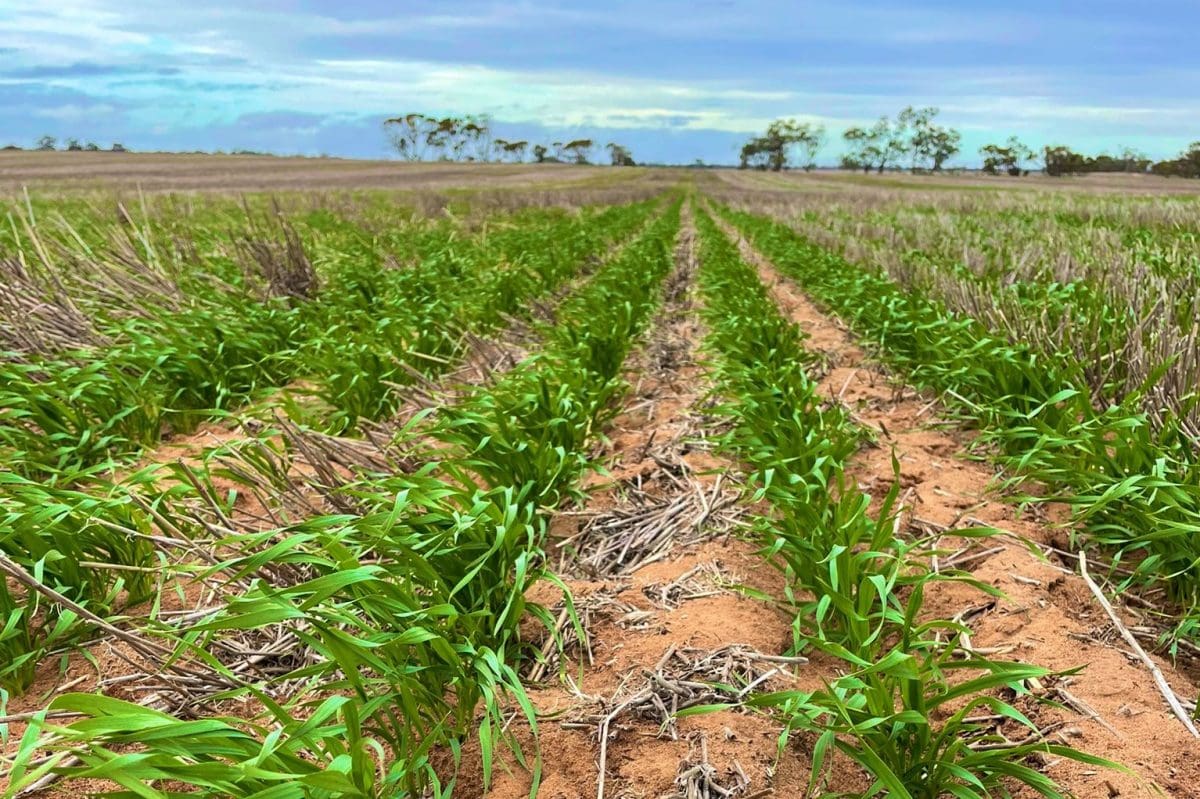
This wheat crop is among the most advanced in north-west Victoria and surrounds, where more rain is needed. Photo: Matt Witney, Dodgshun Medlin
PRICES for feedgrain have mostly firmed in the past week as grower selling in eastern states remains thin and concerns about dry conditions mount in north-west Victoria.
In the week to 9am today, a much-needed and beautifully timed 10-30 millimetres of rain has fallen in most of South Australia’s growing regions, but Victoria has been a mixed bag.
The Wimmera and central Victoria has had 10-20mm, and more in places, but the Mallee has had a patchy 5-10mm.
As export continues to pull whopping tonnages of wheat and barley to coastal terminals, domestic consumers buying hand to mouth are having to bid up to get themselves covered.
Also, growers do not want to add income to their 2020-21 financial year which closes June 30, and the trade, particularly in the northern market, is busy taking delivery in the final window on January-June buyer’s call contracts.
| Nearby | New-crop January | |
| Barley Downs | $305 up $5 | $288 up $12 |
| Wheat Downs | $330 down $2 | $317 up $7 |
| Sorghum Downs | $315 steady | $275 Mar-Apr steady |
| Barley Melbourne | $278 up $3 | $275 steady |
| Wheat Melbourne | $332 up $2 | $327 up $5 |
Table 1: Indicative delivered prices in Australian dollars per tonne.
South retains port focus
While nearly all of Victoria’s winter crop is now in the ground to finish the Australian planting program, it needs further rain, and soon, to underpin even average yield potential.
Wilken Group trading manager Andrew Kelso said further falls were needed for most parts of the Mallee in the state’s north-west.
“It hasn’t had the rain that they’ve had elsewhere,” Mr Kelso said.
“There have been some strong winds, and some patchy germination, and they need another 20-30mm to get a proper germination.”
Victorian prices this week are seen as steady to $5 per tonne dearer on last week, as domestics match bids being generated by export accumulators.
“Prices are pretty steady, and export demand is solid for wheat.”
Victoria’s shipping schedules indicate the barley export program is slowing while wheat continues at pace, but northern consumers appear to be stepping up their buying of barley.
“Queensland and northern New South Wales are still chasing a lot of barley, and I think they’ve run out in SA.”
Mr Kelso said some domestic consumers were coming back to the market to extend their coverage for July forward, and were facing competition from those accumulating for export.
“Grain has tightened up a bit; there’s a solid export pace in both bulk and containers.”
In the southern NSW market, Godde’s Grain and Fertiliser trading manager Peter Gerhardy said cash markets were still firm, and road transport was still difficult to book.
“Trucks are still very very tight, and a lot of that southern NSW grain is going to Melbourne and Geelong for a combination of export and domestic buyers.”
Mr Gerhardy said a lot of business had been written early this year for January-June delivery buyer’s call.
“A lot of those are coming up to expiry now, and once we get to June, we may see trucks free up a bit.”
He said this would be welcome timing, as some consumers were buying hand to mouth, and growers might be ready to let go of some stored or warehoused grain when the new financial year starts next month.
“From a grower perspective, now that we’ve had rain and the new financial year coming, we might see a bit more come to the market.
“There seems to be more barley than wheat left in southern NSW, but there’s still definitely still grain on farm.”
Quiet in north
Sorghum is continuing to price into poultry and pig rations as the Brisbane-Newcastle bulk export program winds down, and feedlots continue to source wheat, which is more readily available than barley, and on a narrowing spread.
“The barley market seems to be a bit shorter, and there’s a bit of consumer demand for June-July,” one trader said.
“It looks like some trade shorts.”
Feedlotters are juggling the reduced numbers of cattle in their yards with their requirement to take delivery of grain deferred from earlier month.
This could see some loads on-sold ahead of new-crop becoming available in October, especially as trucks have become more available.
“Road freight looks like it’s going to be a bit easier for June-July than it has been for the past three or four months.”
On new crops, growers in southern Queensland and northern NSW are forward selling modest tonnages of wheat and barley as their prospects for average or better consolidate based largely on patchy rain over the past week.
Registrations include 20mm at Roma, 19mm at Dalby and 17mm at Surat north of the border, while in NSW, Gunnedah got 48mm, Moree 29mm, Mungindi 15mm, and Narrabri 54mm.
Growers in the northern region have all but finished their summer-crop harvest and winter-crop planting, and trade sources say they are now ready to turn their attention to marketing some current-crop and new-crop tonnage.
